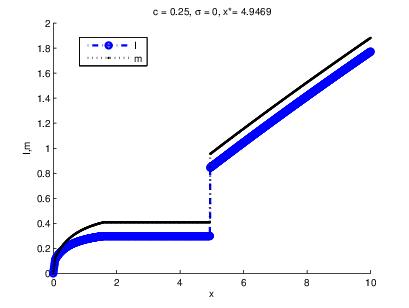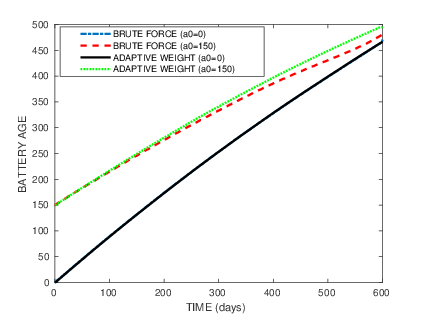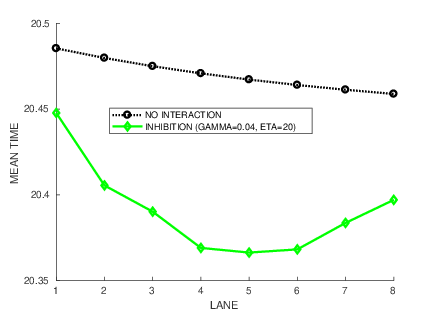Section: New Results
Optimal control of ODEs
Optimal healh insurance design
In [7] we analyze the design of optimal medical insurance under ex post moral hazard, i.e., when illness severity cannot be observed by insurers and policyholders decide for themselves on their health expenditures. The trade-off between ex ante risk sharing and ex post incentive compatibility is analyzed in an optimal revelation mechanism under hidden information and risk aversion. The optimal contract provides partial insurance at the margin, with a deductible when insurers' rates are affected by a positive loading, and it may also include an upper limit on coverage. The potential to audit the health state leads to an upper limit on out-of-pocket expenses.
Health insurance with audit. The 'out-of-pocket' expense () remains bounded.
Optimal Battery Aging: an Adaptive Weights Dynamic Programming Algorithm
In [5] we present an algorithm to handle the optimization over a long horizon of an electric microgrid including a battery energy storage system. While the battery is an important and costly component of the microgrid, its aging process is often not taken into account by the Energy Management System, mostly because of modeling and computing challenges. We address the computing aspect by a new approach combining dynamic programming, decomposition and relaxation techniques. We illustrate this 'adaptive weight' method with numerical simulations for a toy microgrid model. Compared to a straightforward resolution by dynamic programming, our algorithm decreases the computing time by more than one order of magnitude, can be parallelized, and allows for online implementations. We believe that this approach can be used for other applications presenting fast and slow variables.
Optimal battery aging. Comparison of brute-force and adaptive weights algorithm.
Aircraft model identification and trajectory optimization
During the PhD of C. Rommel co-supervised with startup Safety Line, we investigated several formulations and methods for identifying an aircraft dynamics from recorded flight data. In particular, in [14] we introduce a block-sparse Bolasso approach for variable selection. In [12] we study how to quantify the closedness of a trajectory to a set of reference ones, based on the meean marginal likelihood. These works are combined with a gaussian mixture model in [15], allowing for a trade-off between optimality and acceptability of the aircraft trajectories.
Aircraft trajectory optimization. Illustration of the trade-off between performance (consumption) and acceptability (weighted by ).
Microalgae cultivation in a turbid medium
In the context of IPL Algae in Silico, we study in [11] the cultivation of microalgae in a turbid medium. Microalgae cultivation with wastewater is a promising way of reducing the energetic needs for wastewater treatment and the costs of biofuel production. However, the very turbid medium is not favorable for the development of microalgae. Indeed, light, the key element for photosynthesis, rapidly vanishes along depth due to absorption and scattering. Therefore it is crucial to understand the effects of the depth on turbid cultures. In this work, we study theoretically the long-term behavior of a continuous culture of microalgae exposed to a periodic source of light. By allowing periodic variations of the depth and the hydraulic retention time, we show that the microalgae population is forced to a periodic regime. Finally, we address numerically the problem of determining the optimal variations of the depth and the hydraulic retention time for maximizing the productivity of the culture in the periodic regime.
Optimizing running a race on a curved track
Following on a previous study of optimal running strategies [16], we investigate in [9] the case of a curved track. In order to determine the optimal strategy to run a race on a curved track according to the lane number, we introduce a model based on differential equations for the velocity, the propulsive force and the anaerobic energy which takes into account the centrifugal force. This allows us to analyze numerically the different strategies according to the different types of track since the straight line is not always of the same length. In particular, we find that the tracks with shorter straight lines lead to better performances, while the double bend track with the longest straight line leads to the worst performances and the biggest difference between lanes. Then for a race with two runners, we introduce a psychological attraction to follow someone just ahead and the delay to benefit again from this interaction after being overtaken. We provide numerical simulations in different cases. Results are overall consistent with the IAAF rules for lanes drawing, indicating that middle lanes are the best, followed by the exterior lanes, interior lanes being the worst.
Running on a curved track. Mean race times per lane, taking into account centrifugal force and psychological interaction.






